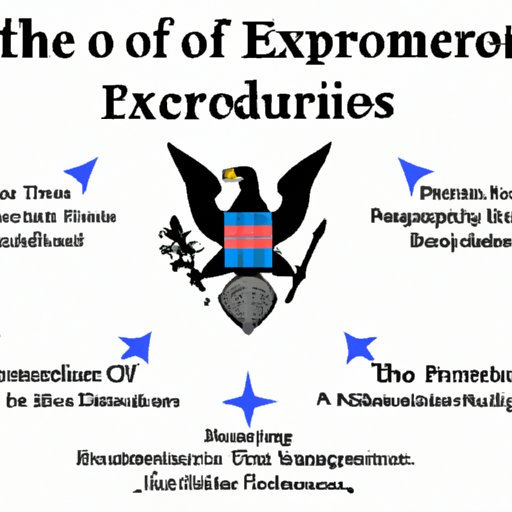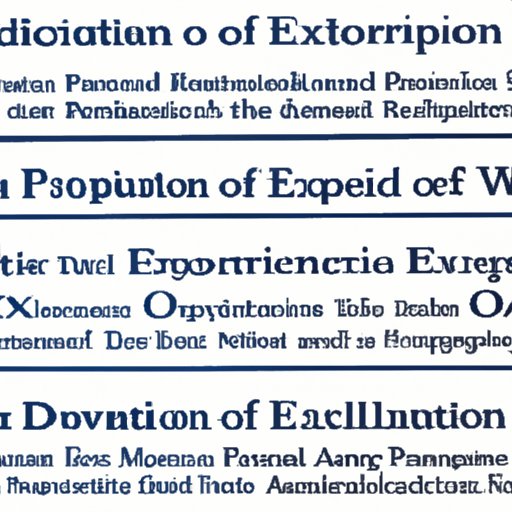Introduction
An executive order is a directive issued by the President of the United States that has the force of law. Executive orders are used by presidents to achieve goals that may not be attainable through legislation or other means. The purpose of executive orders is to provide direction, guidance, and instructions to federal agencies, departments, and employees.
While executive orders have been used since George Washington was president, they have become increasingly important in recent years as a tool for presidents to enact their agendas. This article will explore the basics of how executive orders work, examine their constitutionality, understand the implications of presidential power through executive orders, and compare them to other presidential actions.
Exploring the Basics: How Does an Executive Order Work?
The process for issuing an executive order begins with the president deciding what action he or she wants to take and then drafting the order. Once the order is drafted, it is reviewed by the White House Counsel’s Office and other legal advisors before being sent to the Office of Management and Budget (OMB) for review. After OMB approves the order, it is sent back to the White House for the president to sign. Once the president signs the order, it is officially issued and published in the Federal Register.
The scope of presidential authority under executive orders is broad but not unlimited. Presidents can only issue executive orders within their constitutional and statutory authority. Though executive orders can create new policies and regulations, they cannot override existing laws or create laws that violate the Constitution. Additionally, executive orders cannot be used to appropriate funds or direct private citizens to take specific actions.
Congress also plays an important role in regulating executive orders. Although the president has the authority to issue executive orders, Congress can pass legislation that limits or overrides the president’s authority. Additionally, if Congress does not approve of an executive order, it can pass a joint resolution disapproving of the order.
Examining the Constitutionality of Executive Orders
The constitutionality of executive orders is a subject of ongoing debate. Some argue that executive orders are unconstitutional because they go beyond the scope of the president’s authority. Others argue that executive orders are constitutional because they are based on the president’s powers as outlined in Article II of the Constitution.
The Supreme Court has generally taken the position that executive orders are constitutional if they are based on the president’s powers as outlined in the Constitution. However, the Court has also held that executive orders can be subject to judicial review if they are found to violate the Constitution or existing laws.

Understanding Presidential Power Through Executive Orders
Executive orders can be used to expand the president’s power. They allow presidents to bypass Congress and pursue their own agenda without having to rely on legislative approval. Additionally, executive orders can be used to direct federal agencies and departments to implement the president’s policies and priorities.
However, there are limits on the power of executive orders. Executive orders cannot override existing laws or create laws that violate the Constitution. Additionally, executive orders are subject to judicial review, meaning that courts can overturn executive orders if they are found to be unconstitutional.

Analyzing the Impact of Executive Orders on U.S. Policy
Executive orders have had a significant impact on U.S. policy over the years. Presidents have used executive orders to implement their policy agendas, bypass Congress, and expand their power. For example, President Franklin Roosevelt used executive orders to establish the Works Progress Administration and the National Recovery Administration during the Great Depression. In more recent years, President Obama used executive orders to implement his immigration and climate change policies.
In addition to their immediate effects, executive orders can also have long-term impacts on U.S. policy. Executive orders can set precedents that future presidents can use to expand their power and influence policy. Additionally, executive orders can shape public opinion by setting the tone for debates about certain issues.

Comparing Executive Orders to Other Presidential Actions
Executive orders are similar to other presidential actions in that they are both used to pursue the president’s agenda. However, executive orders differ from other presidential actions in that they have the force of law and are binding on federal agencies and departments. Additionally, executive orders are subject to judicial review, while other presidential actions are not.
Executive orders also differ from other presidential actions in terms of their scope and reach. Executive orders can be used to direct federal agencies and departments to take specific actions, while other presidential actions are generally limited to statements and speeches.
Conclusion
This article has explored how executive orders work, including the process for issuing them, their scope of authority, the role of Congress in regulating them, and their potential long-term impacts on U.S. policy. It has also examined the constitutional basis for executive orders and compared them to other presidential actions.
Executive orders have become an increasingly important tool for presidents to pursue their agendas and expand their powers. While executive orders have the potential to have a lasting impact on U.S. policy, they are also subject to judicial review and must adhere to the parameters of the Constitution. As such, executive orders remain an important and controversial topic in American politics.
(Note: Is this article not meeting your expectations? Do you have knowledge or insights to share? Unlock new opportunities and expand your reach by joining our authors team. Click Registration to join us and share your expertise with our readers.)
